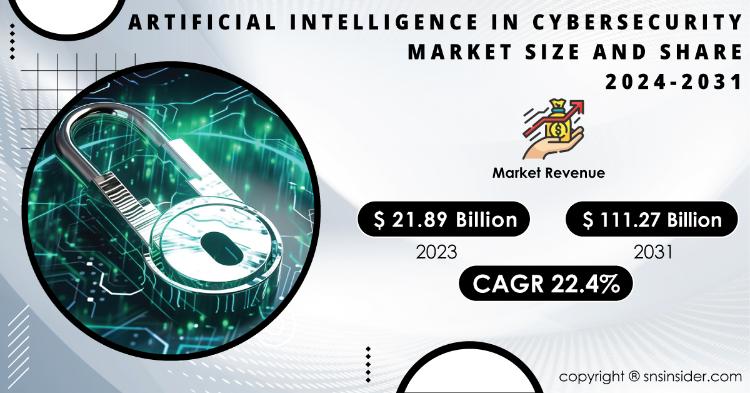Artificial Intelligence in Cybersecurity Market Forecast Shows Promising Growth Opportunities Amidst Industry Evolution
Artificial Intelligence in Cybersecurity Market Forecast Shows Promising Growth Opportunities Amidst Industry Evolution
|
Artificial Intelligence in Cybersecurity Market Scope and Overview The Artificial Intelligence in Cybersecurity Market has emerged as a dynamic and evolving sector, presenting significant opportunities and challenges for businesses across various industries. As stakeholders navigate through a landscape shaped by technological advancements, shifting consumer preferences, and global economic trends, the Artificial Intelligence in Cybersecurity Market Report offers invaluable insights into the market's dynamics such as competitive analysis, regional outlook, key growth drivers, and the transformative potential of the market. In the ever-evolving landscape of cybersecurity, the Artificial Intelligence in Cybersecurity Market emerges as a beacon of innovation and resilience. As cyber threats grow in complexity and volume, traditional security measures struggle to keep pace with the evolving threat landscape. AI-powered cybersecurity solutions offer a paradigm shift in defense mechanisms, leveraging machine learning, behavioral analytics, and threat intelligence to detect, prevent, and respond to cyber threats in real-time. By analyzing vast amounts of data, identifying anomalous patterns, and automating threat response workflows, AI-driven cybersecurity solutions empower organizations to bolster their cyber defenses and mitigate risks effectively. As the battle against cyber threats intensifies, the AI in Cybersecurity Market stands at the forefront of the defense, enabling organizations to stay one step ahead of adversaries and safeguard their digital assets with confidence. Get a Sample Report of Artificial Intelligence in Cybersecurity Market @ https://www.snsinsider.com/sample-request/1993 
Competitive Analysis The Artificial Intelligence in Cybersecurity Market is characterized by intense competition among key players, each vying to establish a dominant position in the industry. From established incumbents to innovative startups, a diverse range of companies compete in the Artificial Intelligence in Cybersecurity Market, offering a wide array of products, services, and solutions to meet the diverse needs of consumers. In addition to established players, a vibrant ecosystem of startups and niche players is emerging, offering specialized solutions and services tailored to specific market segments and consumer preferences. This diverse competitive landscape fosters innovation and ensures that consumers have access to a wide range of options to choose from, driving growth and dynamism in the Artificial Intelligence in Cybersecurity Market. Major Key Players in the Market:
Regional Outlook The Artificial Intelligence in Cybersecurity Market exhibits significant regional variations in terms of market size, growth potential, regulatory environment, and consumer behavior. While North America remains a dominant market, accounting for a significant share of global revenue, other regions such as Europe, Asia Pacific, and Latin America are also experiencing rapid growth and expansion in the Artificial Intelligence in Cybersecurity Market. In North America, factors such as a large consumer base, high disposable income levels, and strong technological infrastructure drive demand. Europe, on the other hand, is characterized by stringent regulatory requirements, cultural diversity, and evolving consumer preferences, presenting both opportunities and challenges for companies operating in the Artificial Intelligence in Cybersecurity Market. In Asia Pacific, rapid urbanization, rising middle-class population, and increasing adoption of digital technologies fuel demand, particularly in emerging economies such as China, India, and Southeast Asian countries. Latin America, while still nascent in terms of market penetration, offers immense growth potential for companies looking to expand their presence in the Artificial Intelligence in Cybersecurity Market. Market Segmentation and Sub-Segmentation Included are: On The Basis of Component
On The Basis of Deployment
On The Basis of Security Type
On The Basis of Technology
On The Basis of Application
On The Basis of Industry Vertical
Key Growth Drivers Analysis Several key factors are driving growth in the Artificial Intelligence in Cybersecurity Market, including:
Conclusion In conclusion, the Artificial Intelligence in Cybersecurity Market report provides valuable insights into the competitive landscape, regional outlook, and key growth drivers shaping the future of the market. As companies navigate through a rapidly evolving landscape, understanding market dynamics and emerging trends is essential for success. By leveraging the insights provided in the Artificial Intelligence in Cybersecurity Market report, companies can identify opportunities, mitigate risks, and make informed decisions to drive growth and innovation in the market. Table of Contents - Major Key Points Covered in the Report
Bethany Stewart
Information & Communication Technology Research Associate |
| Free forum by Nabble | Edit this page |

